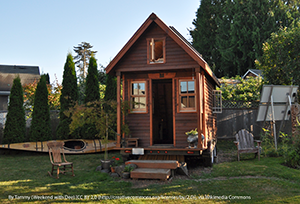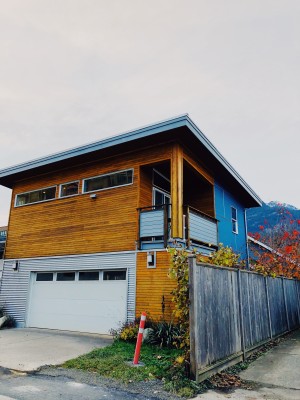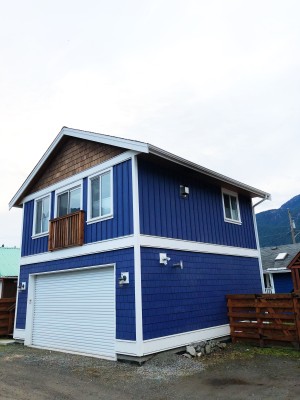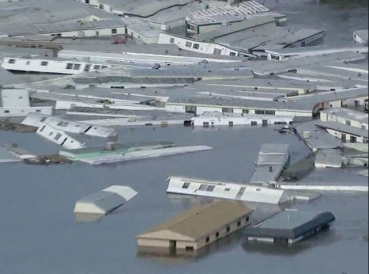Tiny Homes

Tiny (or small) homes in British Columbia are typically defined as a dwelling of any form (apartment, detached dwelling, etc.) that is sized to meet its occupants’ needs with little excess space. Small Homes are typically between 400 – 1400 sq.ft. Tiny Homes are typically between 100 - 400 square feet.
Tiny homes may be built in the District of Squamish as an Accessory Dwelling Units (ADU) and are permitted in all zones that allow a single unit dwelling (learn more about secondary suites). Accessory Dwelling Units have a maximum gross floor area but do not have a minimum gross floor area. If you want to build a small home or a “larger” tiny home that meets the square footage requirement of the Building Code (The building code has several dwelling unit minimum dimensions and minimum ceiling heights that make meeting the building code “challenging” with tiny house designs. For example: the Code stipulates minimum kitchen size of approximately 40 sq.ft., a bedroom of 105 sq.ft., dining room of 75 sq.ft and space allocated for a toilet, shower and/or bathtub) and meets all other requirements of the Zoning Bylaw then you can likely make that dream a reality.
For properties within Flood and Debris Flow Hazard Areas, Permanent concrete pads can be used to meet Flood Construction Level (FCL). If the FCL is 3m or more (most areas of Squamish)the ground floor foundation of the building can be used for storage un-damageable by flood or as a garage. A Qualified Professional would be required to ensure that FCL is met and that small/tiny homes can be safely secured to the concrete platforms. Required Zoning and Building Inspection permits would be applicable. There are cases of “small home” Accessory Dwelling Units built to FCL throughout Squamish.


Mobile Tiny Homes
A mobile tiny home (tiny home on wheels) is typically between 80 -180 sq.ft with special width, length and height restrictions to comply with highway transportation regulations. Mobile tiny homes do not fall under the BC Building Code and therefore present numerous challenges to regulate them within local government.
The landscape of mobile tiny homes is complex as local governments must consider zoning, building codes, flood construction levels, environment protection and life safety and sanitary considerations, among other things. Mobile tiny Homes typically struggle to meet the area and space requirements under the BC Building Code and therefore present occupancy permit challenges.
Mobile tiny homes are not currently legal in the District of Squamish for a variety of reasons outlined below:
- Flood and Debris Flow Hazard Areas:
Most development in Squamish faces the challenge of land that is either within the Cheekeye Fan Debris Flow Hazard Area or within a Flood Hazard Area. To mitigate destruction and increase safety, homes today must be raised above sea level to the highest Flood Construction Level (FCL), calculated and signed by a qualified professional.
Provincial legislation clearly states that local governments cannot exempt FCL level standards for mobile homes (see Flood Hazard Area Land Use Management Guidelines). This means that no Mobile Tiny Home can be legally parked and lived in within the Flood Hazard Area. This is also true of the debris area of the Cheekeye Fan.
- BC Building Code requirements: The Building Code does not regulate for mobile tiny homes or even small/tiny homes that do not meet these standard sizes. This means they are non-compliant and could be subject to fines.
FAQs
-
What is the definition of a tiny home?
Small or Tiny Homes: Small housing in British Columbia is typically defined as a dwelling of any form (apartment, detached dwelling, etc.) that is sized to meet its occupants’ needs with little excess space. Small Homes are typically between 400 – 1400 sq.ft. Tiny Homes are typically between 100 - 400 square feet. Tiny Homes typically struggle to meet the area and space requirements under the BC Building Code and therefore present occupancy permit challenges to local governments.
Mobile Tiny Homes: A tiny home on wheels is typically between 80 -180 sq.ft with special width, length and height restrictions to comply with highway transportation regulations. Mobile homes do not fall under the BC Building Code and therefore present numerous challenges to regulate them within local government.
-
Are mobile tiny homes legal in Squamish?
No: There are currently no zones that allow for mobile tiny homes in Squamish.
-
What is zoning and why is it relevant to tiny homes?
Zoning allows for a community to specifically regulate the use and density of land, siting, size and dimensions of buildings and structures allowed in a specific area. Zoning ensures that heavy industry cannot open up in a residential neighbourhood for example; and it helps to ensure that a downtown or industrial area can thrive by clustering similar types of operations, helping to preserve the form and character of various neighbourhoods.
-
What about modular home parks - how are they zoned in Squamish?
Certain zones in Squamish do allow for mobile (on wheels) or modular homes (on a foundation) intended to accommodate mobile or modular home park development. The District of Squamish Zoning Bylaw allows for mobile homes in the Residential Mobile Home Park (RMH-1) zone and modular homes in the Residential Modular Home (RMH-2) zone. Modular and mobile homes are defined as factory built and require CSA certification before occupancy is approved by our building inspectors. The RMH-1 and RMH-2 zones that you see today in Squamish were established before provincial flood plain legislation was adopted. These homes are therefore considered legally non-conforming dwellings in our current zoning bylaw.
-
What if my neighbour has a mobile tiny home in their backyard?
They are not legal: The District of Squamish operates on a complaint basis and any illegal mobile tiny home could be subject to eviction of the premise and fines, should complaints arise.
-
Why are mobile tiny homes not currently allowed in Squamish?
Most development in Squamish faces the challenge of land that is either within the Cheekeye Fan Debris Flow Hazard Area or within a Flood Hazard Area (see blue area in map below). To mitigate destruction and increase safety, homes today must be raised above sea level to the highest Flood Construction Level (FCL), calculated and signed by a qualified professional.
Provincial legislation clearly states that local governments cannot exempt FCL level standards for mobile homes (see Flood Hazard Area Land Use Management Guidelines). This means that no Mobile Tiny Home can be legally parked and lived in within the Flood Hazard Area. This is also true of the debris area of the Cheekeye Fan.
For areas outside of the Flood Hazard Manangment Area, The Building Code does not regulate for mobile tiny homes or even small/tiny homes that do not meet these standard sizes. This means they are non-compliant and could be subject to fines.
-
Why not? In the case of a flood, can't a mobile tiny home be wheeled away?
Floods can hit suddenly, and in the case of an emergency, vehicles are not always an efficient form of evacuation. Most tiny home owners are usually stationary, and have built decks or more permanent extensions. They are typically located in inconspicuous, not readily accessible backyard locations, are not typically kept “road worthy” and may even have a flat tire or two from being stationary. For these reasons and others it is unlikely that a tiny home could be quickly removed from a Flood Hazard Area in the event of an emergency. An added concern is that, if left in place, mobile tiny homes can become movable large objects, causing damage to neighbouring homes and the community during a flood.

-
Could a mobile tiny home be considered a "Temporary Use" in the BC Building Code?
As the building code states, temporary use is subject to a building inspectors approval as a temporary use. Building inspectors cannot allow a temporary use if the lot is not zoned for that particular use. As it stands, there are no current zones that allow for mobile tiny homes in Squamish. Therefore, at this time, building inspectors cannot issue “temporary use” to legally allow for a mobile tiny home structure.
